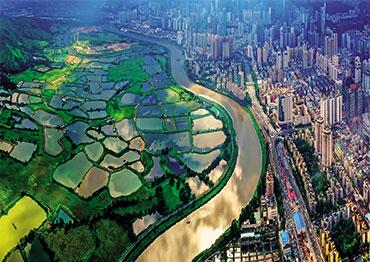But for many experts, the plan is easier said than done. The Northern Metropolis scheme is not the first initiative the Hong Kong government launched to develop northern Hong Kong. In a plan released in 2007 titled “Hong Kong 2030: Planning Vision and Strategy,” Hong Kong authorities considered transforming New Territories localities including Fanling North, Kwu Tung North and Hung Shui Kiu into new development areas (NDAs).
Although the report included plans to move some high-tech firms to the New Territories, it ended up focusing on developing residential projects aimed at decentralizing the population from central Hong Kong.
In a commentary published by the Hong Kong Economic Journal on November 21, 2021, Hongbin Cai, dean of Hong Kong University Business School, warned that the Hong Kong government must have clear goals for its Northern Metropolis scheme to prevent it from becoming yet another residential project.
“The main purpose of the Northern Metropolis plan must be made very clear. Is it to promote rural development of the New Territories, to decentralize the population in central Hong Kong, to solve housing problems, or to build Hong Kong into an international innovation hub?” Cai said. He stressed that while the plan will help solve many other problems, the government must prioritize promoting innovation and technology industries in its development plan.
The Hong Kong government has also previously launched several initiatives focused on high-tech industries. Just one year after Hong Kong returned to China in 1997, the Hong Kong government announced a plan to develop a “cyberport” project aimed at attracting global tech companies. But as developers handled the project, it ended up more focused on real estate.
In 2001, Hong Kong launched the Hong Kong Science Park project in Tai Po, an eastern New Territories district. Although the project nurtured several impressive unicorns, its impact is relatively limited given the project’s small scale of 15 buildings.
According to Professor Cai, given the size of Hong Kong’s market, the city cannot build a strong and competitive high-tech industry unless it goes beyond Hong Kong to integrate with the highly-developed innovation sectors in neighboring Shenzhen. By further integrating with Shenzhen, Hong Kong could attract more professionals and have access to the massive Chinese mainland market to commercialize its innovative technologies.
Home to some of China’s biggest tech companies such as Tencent, Huawei, DJI, and Insta360, Shenzhen is dubbed China’s Silicon Valley. Its economy grew from just one-tenth of that of Hong Kong in 1997 to 2.42 trillion yuan (US$362b) in 2018, surpassing Hong Kong for the first time.
In 2017, the Hong Kong-Shenzhen Innovation and Technology Park was launched, which was planned to occupy 87 hectares for the research and development of biomedicine, chemistry, physics, engineering and AI, in Lok Ma Chau Loop, a border area between Hong Kong and Shenzhen. Its first batch of eight buildings is expected to be completed by the end of 2024.
As the central government’s Greater Bay Area plan takes shape, which aims to link Hong Kong, Macao and nine cities in the Pearl River Delta region into an integrated economic and business hub, it paves the way for the Hong Kong government’s ambitious Northern Metropolis plan.

 Old Version
Old Version


